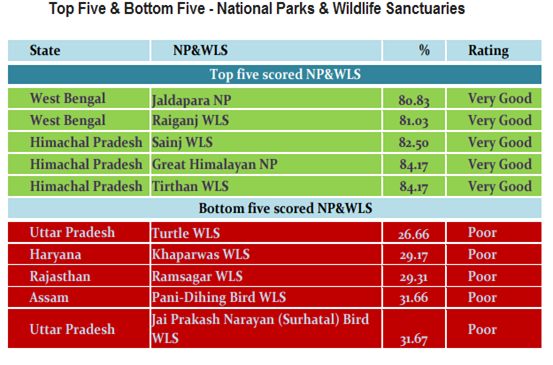Management Effectiveness Evaluation Of National Parks And Wildlife Sanctuaries
- 12 Jan 2021
The Ministry of Environment, Forest and Climate Change has released Management Effectiveness Evaluation (MEE) of 146 National Park and Wildlife Sanctuaries in the country.
- The 143 National Parks and Wildlife Sanctuaries arranged in five regions viz. Northern, Southern, Eastern, Western and North-eastern for evaluation. The eastern region of India presents highest overall mean MEE Score of 66.12% and the Northern region represents the lowest mean MEE Score of 56%.

What is Management Effectiveness Evaluation (MEE)?
Protected area (PA) management effectiveness evaluation (MEE) is defined as the assessment of how well NP&WLS are being managed—primarily, whether they are protecting their values and achieving the goals and objectives agreed upon. The term ‘management effectiveness’ reflects three main themes of PA management:
- Design issues relating to both individual sites and PA systems,
- The adequacy and appropriateness of management systems and processes, and
- Delivery of the objectives of NP&WLS, including conservation of values.
Assessment Process
The assessment process of India's National Park and Wildlife Sanctuaries was adopted from International Union for the Conservation of Nature (IUCN) World Commission on Protected Areas (WCPA) framework of Management Effectiveness Evaluation (MEE).
- There are 30 ''Headline Indicators'' developed under six elements of MEE framework suitable in Indian context for evaluation.
- Each ''Headline Indicator'' had four possible answers, ''poor'' (score 2.5), ''fair'' (score 5), ''good'' (score 7.5) and ''very good'' (score 10) to choose for evaluation. The total score would be 300 by including a maximum score of all questions.
- The ratings are assigned in four categories, as Poor -– up to 40 per cent; Fair -- 41 to 59 per cent; Good -- 60 to 74 per cent; Very Good -– 75 per cent and above.
- The assessment criteria and indicators look beyond the traditional concepts, include issues of animal welfare, husbandry and sustainability of resources and finance.
The Ministry of Environment, Forest and Climate Change also launched two other initiatives:
- Management Effectiveness Evaluation of Indian Zoos (MEE-ZOO): This framework proposes guidelines, criteria and indicators for evaluation of zoos of the country in a manner which is discrete, holistic and independent. The MEE-ZOO exercise is moving towards developing highest standards in zoos across India and adhering to core values of accountability, transparency, innovation, use of technology, collaboration and integrity to achieve the mandate of conservation of endangered species.
- MEE of Marine Protected Areas: A new framework for MEE of Marine Protected Areas jointly prepared by Wildlife Institute of India (WII) and the Ministry of Environment - will be a very useful document to implement.




